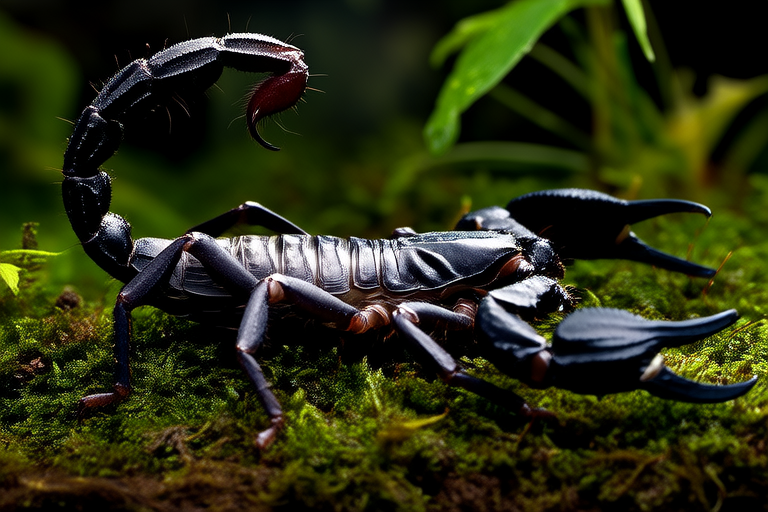
How the Heterometrus Spinifer Became an Internet Sensation and Why You Should Care
The world of the internet is vast and ever-changing, with new sensations emerging daily. Among these, one creature has managed to capture the hearts and minds of millions: the Heterometrus spinifer, a fascinating scorpion native to Southeast Asia. This article will explore the journey of this species from relative obscurity to internet stardom, examining its unique characteristics, the pivotal moments that propelled it into the digital spotlight, and the reasons why its story is important.
The Heterometrus Spinifer: An Introduction
The Heterometrus spinifer, also known as the hairy forest scorpion, is a remarkable arachnid that resides primarily in the tropical forests of Thailand, Malaysia, and Indonesia. This species is distinguished by its elongated body, typically measuring between 8 to 14 centimeters in length. Its most striking feature is the dense layer of hair-like structures covering its exoskeleton, which gives it a unique texture and appearance. These hairs serve a dual purpose; they help the scorpion detect vibrations in its environment and provide camouflage among the foliage.
In terms of habitat, the Heterometrus spinifer thrives in humid, densely vegetated areas. It prefers to reside in burrows under rocks or logs, where it can stay hidden from predators and maintain the moisture levels necessary for its survival. The scorpion’s nocturnal nature means it is most active during the night, hunting small insects and other invertebrates. Despite its formidable appearance, the Heterometrus spinifer is not particularly aggressive towards humans, preferring to avoid confrontation.
The Rise to Internet Fame
The journey of the Heterometrus spinifer to internet fame began with a series of viral videos showcasing its unique appearance and behavior. One of the earliest instances occurred when a video of a scorpion handler interacting with a Heterometrus spinifer went viral on social media platforms like YouTube and TikTok. In the video, the handler demonstrated the scorpion’s docile nature, dispelling common myths about scorpions being inherently dangerous.
This video was just the beginning. As more people shared similar content, the Heterometrus spinifer became a symbol of the beauty and diversity found within the animal kingdom. The species’ distinct appearance and gentle demeanor resonated with viewers, leading to a surge in interest and engagement. Memes and challenges involving the scorpion soon followed, further cementing its status as an internet sensation. For instance, a popular meme featured the Heterometrus spinifer with exaggerated expressions, humorously anthropomorphizing the creature.
Cultural Impact
The cultural impact of the Heterometrus spinifer’s internet fame extends beyond mere entertainment. The species has become a subject of fascination for many, inspiring discussions about biodiversity and the importance of preserving natural habitats. Social media communities dedicated to the scorpion have emerged, fostering a sense of camaraderie among enthusiasts who share tips, stories, and images. These communities often serve as platforms for raising awareness about environmental issues and promoting conservation efforts.
The trend of featuring the Heterometrus spinifer in various forms of media has also led to increased interest in related topics, such as scorpion biology and ecology. Educational content, including documentaries and articles, has been produced to cater to this growing audience, offering insights into the life cycle, diet, and behavior of the scorpion. This educational aspect of the trend has played a crucial role in demystifying scorpions and fostering a greater appreciation for these creatures.
Why You Should Care
Beyond its appeal as an internet sensation, the Heterometrus spinifer plays a vital role in its ecosystem. As predators, scorpions help control populations of insects and other invertebrates, contributing to the balance of their local environments. They also serve as indicators of environmental health, as changes in their population can signal broader ecological shifts. Understanding and protecting the Heterometrus spinifer is essential for maintaining the integrity of the ecosystems in which they live.
Unfortunately, the very factors that make the Heterometrus spinifer appealing—its unique appearance and gentle nature—also place it at risk. Habitat destruction due to deforestation and urbanization threatens the species’ survival, as does the illegal pet trade, which often leads to the capture and removal of individuals from the wild. These threats highlight the urgency of conservation efforts aimed at protecting the Heterometrus spinifer and its habitat.
To support conservation efforts, individuals can take several actions. Firstly, raising awareness about the importance of biodiversity and the threats faced by species like the Heterometrus spinifer is crucial. Engaging with social media platforms and participating in online communities can amplify these messages. Secondly, supporting organizations dedicated to wildlife conservation through donations or volunteer work can make a tangible difference. Lastly, advocating for policies that protect natural habitats and regulate the pet trade can help ensure the long-term survival of the Heterometrus spinifer and other vulnerable species.
Conclusion
The journey of the Heterometrus spinifer from an obscure species to an internet sensation is a testament to the power of digital media in connecting people with the wonders of the natural world. By learning about this remarkable creature, we not only gain insight into the intricacies of its biology but also recognize the broader implications of its existence. The Heterometrus spinifer serves as a reminder of the delicate balance within ecosystems and the importance of conservation efforts. By caring for this scorpion and its environment, we contribute to the preservation of Earth’s rich biodiversity for future generations.






